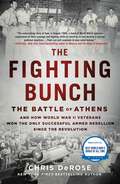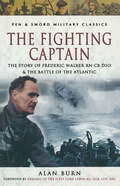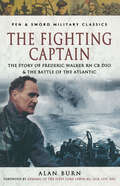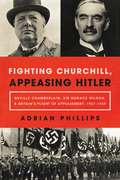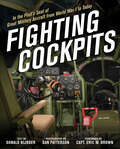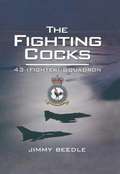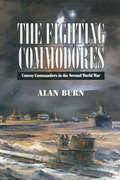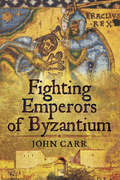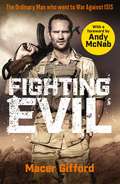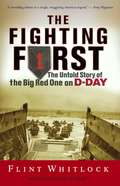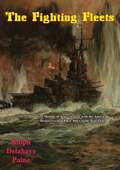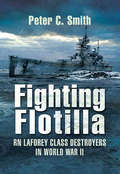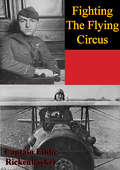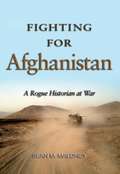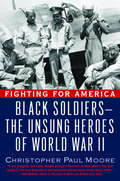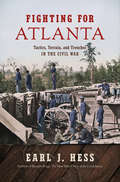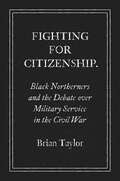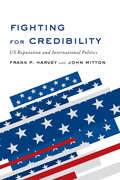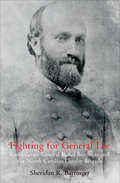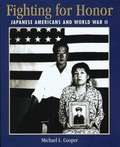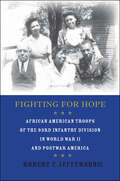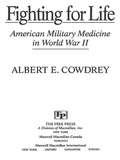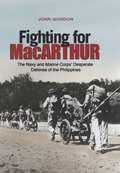- Table View
- List View
The Fighting Bunch: The Battle of Athens and How World War II Veterans Won the Only Successful Armed Rebellion Since the Revolution
by Chris DeRoseIn The Fighting Bunch: The Battle of Athens and How World War II Veterans Won the Only Successful Armed Rebellion Since the Revolution, New York Times bestselling author Chris DeRose reveals the true, never-before-told story of the men who brought their overseas combat experience to wage war against a corrupt political machine in their hometown.Bill White and the young men of McMinn County answered their nation's call after Pearl Harbor. They won the freedom of the world and returned to find that they had lost it at home. A corrupt political machine was in charge, protected by violent deputies, funded by racketeering, and kept in place by stolen elections - the worst allegations of voter fraud ever reported to the Department of Justice, according to the U.S. Attorney General. To restore free government, McMinn's veterans formed the nonpartisan GI ticket to oppose the machine at the next election.On Election Day, August 1, 1946, the GIs and their supporters found themselves outgunned, assaulted, arrested, and intimidated. Deputies seized ballot boxes and brought them back to the jail. White and a group of GIs - "The Fighting Bunch" - men who fought and survived Guadalcanal, the Bulge, and Normandy, armed themselves and demanded a fair count. When they were refused the most basic rights they had fought for, the men, all of whom believed they had seen the end of war, returned to the battlefield and risked their lives one last time. For the past seven decades, the participants of the "Battle of Ballots and Bullets" and their families kept silent about that conflict. Now in The Fighting Bunch, after years of research, including exclusive interviews with the remaining witnesses, archival radio broadcast and interview tapes, scrapbooks, letters, and diaries, Chris DeRose has reconstructed one of the great untold stories in American history.
The Fighting Captain: The Story of Frederic Walker RN CB DSO & The Battle of the Atlantic (Pen & Sword Military Classics)
by Alan BurnCaptain F J Walker, RN, did more than any other man at sea to win the Battle of the Atlantic, a vicious and unrelenting struggle which Churchill described as the dominating factor throughout World War Two. He was a formidable figure and one of the greatest fighting captains in the Royal Navy, sinking twenty U-boats. For this he was awarded a CB and four DSOs. A month after D-Day, exhausted by his continuous actions at sea against the enemy and his successful exertions to keep the U-boats out of the English Channel to ensure the safe passage of the Allied landings at D-day, he went ashore in Liverpool after a patrol. His ships and the men he had trained and inspired were already back at sea when he died on the 9 July, 1944, aged 48. His ships went on to sink another nine U-boats, bringing his flotillas' total up to twenty-nine, before the U-boat fleet finally surrendered. Fifteen of which were sunk by Walker’s own ship, HMS Starling.
The Fighting Captain: The Story of Frederic Walker RN CB DSO & The Battle of the Atlantic (Pen & Sword Military Classics)
by Alan BurnA riveting account of the World War II naval career of the man who did more to win the Battle of the Atlantic than any other officer at sea.Captain F. J. Walker, RN, dedicated his life to defeating the Germans—and Karl Dönitz, Führer der U-Boote, in particular—by containing the U-boats, wearing them down, and sending them back to their bunkers.He was a formidable figure and one of the greatest fighting captains in the Royal Navy, sinking twenty U-boats. For this he was awarded a CB and four DSOs. A month after D-Day, exhausted by his continuous actions at sea against the enemy and his successful exertions to keep the U-boats out of the English Channel to ensure the safe passage of the Allied landings at D-day, he went ashore in Liverpool after a patrol. His ships and the men he had trained and inspired were already back at sea when he died on the 9 July, 1944, aged 48. His ships went on to sink another nine U-boats, bringing his flotillas’ total up to twenty-nine, before the U-boat fleet finally surrendered. Fifteen of which were sunk by Walker’s own ship, HMS Starling.
Fighting Churchill, Appeasing Hitler: Neville Chamberlain, Sir Horace Wilson, And Britain's Plight Of Appeasement: 1937-1939
by Adrian PhillipsA radically new view of the British policy of appeasement in the late 1930s, identifying the individuals responsible for a variety of miscalculations and moral surrender that made World War II inevitable. Appeasement failed in all its goals. The kindest thing that can be said of it is that postponed World War II by one year. Its real effect was to convince Hitler and Mussolini that Britain was weak and afraid of confrontation, encouraging them to ever-greater acts of aggression. The turning point of the Czech crisis in September 1938 came when Wilson saw Hitler on his own and left him convinced that Britain was bluffing and would not go to war to defend Czechoslovakia. The dismemberment of Czechoslovakia that followed was not the end of appeasement. The Anglo-German Declaration was Chamberlain’s personal vanity project but both Chamberlain and Wilson believed that it genuinely brought "peace for our time." Chamberlain and Wilson blindly pursued bilateral friendship between Britain and the dictators and ferociously resisted alternative policies such as working with France, the Soviet Union, or the U.S. to face down the dictators. They resisted all-out rearmament which would have put the economy on a war footing. These were all the policies advocated by Winston Churchill, the most dangerous opponent of appeasement. Churchill was a hated figure for Chamberlain and Wilson. They could not accept Churchill’s perception that that Hitler was the implacable enemy of peace and Britain, and opposing him became an end in itself for them. Churchill and Wilson had been bitter adversaries since early in their careers because of an incident that Fighting Churchill, Appeasing Hitler reveals publicly for the first time. Chamberlain had a fraught relationship with Churchill long before appeasement became an issue. Neither Chamberlain nor Wilson had any experience of day-to-day practical diplomacy. Both thought that the dictators would apply the same standards of rationality and clarity to the policies of Italy and Germany that applied in Britain. They could not grasp that Fascist demagogues operated in an entirely different way to democratic politicians. The catastrophe of the Chamberlain/Wilson appeasement policy offers a vital lesson in how blind conviction in one policy as the only alternative can be fatally damaging.
Fighting Cockpits: In the Pilot's Seat of Great Military Aircraft from World War I to Today
by Donald Nijboer Dan PattersonWhat was it like to sit in the pilot's seat and take control of a P-51 Mustang in World War II? What about an F-14 Tomcat at the height of the Cold War? Or a Lockheed Martin F-22 Raptor today? The cockpits of these fighter and bomber aircraft are revealed in Fighting Cockpits. Showcasing more than 50 of the world's most famous combat cockpits from early World War I aircraft to present-day fighters, this book includes more than 200 rich color photos from photographer Dan Patterson, as well as detailed history about combat cockpit development from aviation expert and historian Donald Nijboer.Presented in large-format, you'll be blown away by studio shot spreads of views from the cockpits, vintage photographs of the aircrafts in action, and modern photography of surviving crafts. This book will complete any history buff or aviation enthusiast's library.Aircraft include:Wind in the Wires: Nieuport 28, Royal Aircraft Factory S.E.5, Bristol F.2, Fokker Dr.I, Sopwith Camel, Sopwith Triplane, AEG G.IV, SPAD VII, Halberstadt CL.IV, Fokker D.VIIThe Rise of the Monoplane: Martin MB-2, Hawker Hind, Fiat CR.32, Boeing P-26 Peashooter, Curtiss F9C, Sparrowhawk, Vought SB2U Vindicator, Westland Lysander, PZL P.11World War II: Supermarine Spitfire, Messerschmitt Bf 109, Republic P-47 Thunderbolt, North American P-51 Mustang, Handley Page Halifax, Vickers Wellington, Focke-Wulf Fw 190 Wurger, Fairey Firefly, Fiat CR.42, Ilyushin Il-2 Sturmovik, Heinkel He 219 Uhu, Kawasaki Ki-45 Toryu, Curtiss SB2C Helldiver, Northrop P-61 Black Widow, Boeing B-17 Flying Fortress, Boeing B-29 Superfortress, Dornier Do 335 Pfeil, Messerschmitt Me 262 Schwalbe, Arado Ar 234 BlitzCold War to the Present: North American F-86 Sabre, Boeing B-52 Stratofortress, Grumman A-6 Intruder, General Dynamics F-111 Aardvark, Hawker Siddeley Harrier, McDonnell Douglas/Boeing F-15 Eagle, Grumman F-14 Tomcat, Fairchild Republic A-10 Thunderbolt II, General Dynamics/Lockheed Martin F-16 Fighting Falcon, Mikoyan MiG-29, Rockwell B-1 Lancer, Lockheed Martin F-117 Nighthawk, Lockheed Martin F-22 Raptor, Lockheed Martin F-35 Lightning II Joint Strike Fighter
The Fighting Cocks: 43 (Fighter) Squadron
by Jimmy BedleIn April 1916, a group of early aviators gathered in the fields beneath the crags and ramparts of Stirling Castle to form what was to become one of the Royal Air Forces most distinguished fighter squadrons.Few squadrons can match the history of 43 Squadron which has included being the first to undertake ground attack operations during the First World War, shooting down the first enemy aircraft over England in the Second World War, and achieving the remarkable double of shooting down 6 enemy aircraft in one day in both World Wars. Its distinctive emblem of the Fighting Cock embodies the spirit and resilience of a fighter squadron that has been in the vanguard of RAF operations for almost a century. Perhaps the Fighting Cocks finest period occurred during the Battle of Britain when its Hurricanes destroyed 60 enemy aircraft with a further thirteen probables and twenty-five more damaged.With the advent of the jet age, 43 Squadron became the first unit to fly the Hunter, seeing operational duties in Aden, before re-equipping with the Phantom until the end of the Cold War. This new edition of the Fighting Cocks history brings the story up to date and covers its 20 years of service with the Tornado F3, including the Gulf War, NATO operations over Bosnia, and the Iraq War. * This new edition of the Fighting Cocks history brings the story up to date * Few squadrons can match the history of 43 Squadron* Fighting Cock embodies the spirit and resilience of a fighter squadron that has been in the vanguard of RAF operations for almost a century
The Fighting Commodores: Convoy Commanders in the Second World War
by Alan BurnAs Britain came terrifyingly close to running out of supplies during the Second World War, a group of retired senior naval officers returned to the sea in the role of convoy commanders, and thereby turned the tide.
Fighting Emperors of Byzantium
by John CarThe Eastern Roman or 'Byzantine' Empire had to fight for survival throughout its long history so military ability was a prime requisite for a successful Emperor. John Carr concentrates on the personal and military histories of the more capable war fighters to occupy the imperial throne at Constantinople. They include men like it's founder Constantine I , Julian, Theodosius, Justinian, Heraclius, Leo I, Leo III, Basil I, Basil II (the Bulgar-slayer), Romanus IV Diogenes, Isaac Angelus, and Constantine XI. Byzantium's emperors, and the military establishment they created and maintained, can be credited with preserving Rome's cultural legacy and, from the seventh century, forming a bulwark of Christendom against aggressive Islamic expansion. For this the empire's military organization had to be of a high order, a continuation of Roman discipline and skill adapted to new methods of warfare. Thus was the Empire, under the leadership of its fighting emperors, able to endure for almost a thousand years after the fall of Rome.
Fighting Evil: The Ordinary Man who went to War Against ISIS
by Macer GiffordA visceral, riveting, no-holds-barred military memoir told from the front line of the war against ISIS with a foreword by Andy McNab. In the summer of 2014 the world watched in horror as the black flag of ISIS swept all before it. Mosul, the second largest city in Iraq fell, ISIS proclaimed the caliphate and the horror mounted: from the mass murder, rape and enslavement of the Yazidis to the public beheading of journalists by British jihadis. For Macer Gifford it wasn't enough to ask why more wasn't being done, he knew he had to act. So, he left his job in the city, split from his girlfriend and a few weeks later found himself illegally crossing the border into Syria to join the Kurdish YPG in their fight against the savagery of ISIS.Macer Gifford became one of longest serving British International Volunteers and one of the only few to be promoted to be a Commander in the YPG. He fought alongside the Kurds (and their Syrian Allies) for three long tours of duty from the dawn of the caliphate all the way to its military defeat in the ruins of Raqqa in 2017, sniping at the final deadly wave of suicide bombers as they burst from the rubble. Along the way, he made - and lost - many friends. This is the only complete account of the war against the Caliphate by the Kurds and the remarkable and often eccentric band of international volunteers who fought alongside them.
Fighting Evil: The Ordinary Man who went to War Against ISIS
by Macer GiffordA visceral, riveting, no-holds-barred military memoir told from the front line of the war against ISIS with a foreword by Andy McNab. In the summer of 2014 the world watched in horror as the black flag of ISIS swept all before it. Mosul, the second largest city in Iraq fell, ISIS proclaimed the caliphate and the horror mounted: from the mass murder, rape and enslavement of the Yazidis to the public beheading of journalists by British jihadis. For Macer Gifford it wasn't enough to ask why more wasn't being done, he knew he had to act. So, he left his job in the city, split from his girlfriend and a few weeks later found himself illegally crossing the border into Syria to join the Kurdish YPG in their fight against the savagery of ISIS.Macer Gifford became one of longest serving British International Volunteers and one of the only few to be promoted to be a Commander in the YPG. He fought alongside the Kurds (and their Syrian Allies) for three long tours of duty from the dawn of the caliphate all the way to its military defeat in the ruins of Raqqa in 2017, sniping at the final deadly wave of suicide bombers as they burst from the rubble. Along the way, he made - and lost - many friends. This is the only complete account of the war against the Caliphate by the Kurds and the remarkable and often eccentric band of international volunteers who fought alongside them.
The Fighting First: The Untold Story of the Big Red One on D-Day
by Flint Whitlock<p><i>The Fighting First</i> recounts the untold story of the 1st Infantry Division's role in the invasion of France at Normandy. Using primary sources, official records, interviews, and unpublished memoirs by the veterans themselves, Flint Whitlock has crafted a riveting, gut-wrenching, personal story of courage under fire. <p>Operation Overlord-the Allied invasion of Normandy on 6 June 1944-was the most important battle of World War II, and Omaha Beach was the hottest spot in the entire operation. Leading the amphibious assault on the "Easy Red" and "Fox Green" sectors of Omaha Beach was the U.S. Army's 1st Infantry Division-"The Big Red One"-a tough, swaggering outfit with a fine battle record. <p>The saga of the Big Red One, however, did not end with the storming of the beachhead, but continued across France, Belgium, and into Germany itself, where the division fought in the battles for Aachen, the Huertgen Forest, and the Battle of the Bulge. <i>The Fighting First</i> is an inspiring, graphic, and often heart-breaking story of young American soldiers performing their missions with spirit, humor, and determination.</p>
The Fighting Fleets: Five Months of Active Service with the American Destroyers and Their Allies in the War Zone
by Ralph Delahaye PaineA look at the day-to-day work of the Allied Naval Forces during the First World War, particularly in regard to the relationship between the British navy and the U.S. navy in 1918. It is partly based on the author’s five months of active service with the American destroyers, and makes for some interesting reading about World War I submarines and destroyers. Ralph D. Paine was an American author of many maritime books and a friend of Stephen Crane, author of The Red Badge of Courage.
Fighting Flotilla: RN Laforey Class Destroyers in World War II
by Peter C. SmithThe Laforays were the largest, most powerfully armed and successful ships of this type to see frontline action with the Royal Navy in WWII. They were also the handsomest warships to see service and presented a perfect combination of power and speed. They were assigned to the most dangerous theaters of war including Force H, sailing between Gibraltar and Malta, from where they operated against the German supply lines to North Africa. They escorted minelayers into the German backyard in the North Sea and their convoy escort work in the North Atlantic proved them to be highly effective hunter killers of the U-Boat packs that threatened every cargo ship carrying vital supplies to the UK. Such was the pace of their war, that out of the eight ships of the class only one survived the war.The book also includes chapters on their origin, planning and building, wartime operations and indices cover weapon systems, general fittings and complements and battle honors for each ship in the class.
Fighting The Flying Circus [Illustrated Edition]
by Captain Eddie RickenbackerIncludes Aerial Warfare During World War I Illustrations Pack with 115 maps, plans, and photos.Captain Rickenbacker, originally from Ohio, was best known as one of the Commanders of the 94th "Hat-in-the-Ring" Squadron, a crack unit of pilots which included many former members of the famed Lafayette Escadrille. The 94th ended the war in France with the highest number of air victories of any American squadron. Captain Rickenbacker himself was credited with 26 aerial victories all within the last six months of the war, he was decorated with the Congressional Medal Of Honor for his inspirational leadership and fearless flying.
Fighting for Afghanistan
by Sean M. MaloneySean Maloney, the first Canadian military historian to go into battle since the Korean War, brings the intensity of near-fatal experiences in southern Afghanistan to his description of events in 2006 when the Taliban insurgency threatened to overwhelm the U.S.-led coalition. He explains how the shift from small-scale guerilla attacks and urban terrorism to near-conventional warfare caught everyone by surprise and forced a small, under-equipped Canadian battle group into a desperate series of battles that ultimately saved Kandahar City. Maloney tells exactly what happened at all levels, from infantry company to battle group to brigade headquarters. He is the first to provide such details and give historical context, while helping readers understand the difficulties involved in complex coalition operations.
Fighting for America: Black Soldiers-the Unsung Heroes of World War II
by Christopher Paul MooreThe African-American contribution to winning World War II has never been celebrated as profoundly as in Fighting for America. In this inspirational and uniquely personal tribute, the essential part played by black servicemen and -women in that cataclysmic conflict is brought home. Here are letters, photographs, oral histories, and rare documents, collected by historian Christopher Moore, the son of two black WWII veterans. Weaving his family history with that of his people and nation, Moore has created an unforgettable tapestry of sacrifice, fortitude, and courage. From the 1,800 black soldiers who landed at Normandy Beach on D-Day, and the legendary Tuskegee Airmen who won ninety-five Distinguished Flying Crosses, to the 761st Tank Battalion who, under General Patton, helped liberate Nazi death camps, the invaluable effort of black Americans to defend democracy is captured in word and image. Readers will be introduced to many unheralded heroes who helped America win the war, including Dorie Miller, the messman who manned a machine gun and downed four Japanese planes; Robert Brooks, the first American to die in armored batt Lt. Jackie Robinson, the future baseball legend who faced court-martial for refusing to sit in the back of a military bus; an until now forgotten African-American philosopher who helped save many lives at a Japanese POW c& even the author's own parents: his mother, Kay, a WAC when she met his father, Bill, who was part of the celebrated Red Ball Express. Yet Fighting for America is more than a testimonial; it is also a troubling story of profound contradictions, of a country still in the throes of segregation, of a domestic battleground where arrests and riots occurred simultaneously with foreign service-and of how the war helped spotlight this disparity and galvanize the need for civil rights. Featuring a unique perspective on black soldiers, Fighting for America will move any reader: all who, like the author, owe their lives to those who served.
Fighting for Atlanta: Tactics, Terrain, and Trenches in the Civil War (Civil War America)
by Earl J. HessAs William T. Sherman's Union troops began their campaign for Atlanta in the spring of 1864, they encountered Confederate forces employing field fortifications located to take advantage of rugged terrain. While the Confederates consistently acted on the defensive, digging eighteen lines of earthworks from May to September, the Federals used fieldworks both defensively and offensively. With 160,000 troops engaged on both sides and hundreds of miles of trenches dug, fortifications became a defining factor in the Atlanta campaign battles. These engagements took place on topography ranging from Appalachian foothills to the clay fields of Georgia's piedmont.Leading military historian Earl J. Hess examines how commanders adapted their operations to the physical environment, how the environment in turn affected their movements, and how Civil War armies altered the terrain through the science of field fortification. He also illuminates the impact of fighting and living in ditches for four months on the everyday lives of both Union and Confederate soldiers. The Atlanta campaign represents one of the best examples of a prolonged Union invasion deep into southern territory, and, as Hess reveals, it marked another important transition in the conduct of war from open field battles to fighting from improvised field fortifications.
Fighting for Citizenship: Black Northerners and the Debate over Military Service in the Civil War (Civil War America)
by Brian TaylorIn Fighting for Citizenship, Brian Taylor complicates existing interpretations of why black men fought in the Civil War. Civil War–era African Americans recognized the urgency of a core political concern: how best to use the opportunity presented by this conflict over slavery to win abolition and secure enduring black rights, goals that had eluded earlier generations of black veterans. Some, like Frederick Douglass, urged immediate enlistment to support the cause of emancipation, hoping that a Northern victory would bring about the end of slavery. But others counseled patience and negotiation, drawing on a historical memory of unfulfilled promises for black military service in previous American wars and encouraging black men to leverage their position to demand abolition and equal citizenship. In doing this, they also began redefining what it meant to be a black man who fights for the United States.These debates over African Americans' enlistment expose a formative moment in the development of American citizenship: black Northerners' key demand was that military service earn full American citizenship, a term that had no precise definition prior to the Fourteenth Amendment. In articulating this demand, Taylor argues, black Northerners participated in the remaking of American citizenship itself—unquestionably one of the war's most important results.
Fighting for Credibility: US Reputation and International Politics
by Frank P. Harvey John MittonWhen Bashar al-Assad used chemical weapons against his own people in Syria, he clearly crossed President Barack Obama’s "red line." At the time, many argued that the president had to bomb in order to protect America's reputation for toughness, and therefore its credibility, abroad; others countered that concerns regarding reputation were overblown, and that reputations are irrelevant for coercive diplomacy. Whether international reputations matter is the question at the heart of Fighting for Credibility. For skeptics, past actions and reputations have no bearing on an adversary’s assessment of credibility; power and interests alone determine whether a threat is believed. Using a nuanced and sophisticated theory of rational deterrence, Frank P. Harvey and John Mitton argue the opposite: ignoring reputations sidesteps important factors about how adversaries perceive threats. Focusing on cases of asymmetric US encounters with smaller powers since the end of the Cold War including Bosnia, Kosovo, Iraq, and Syria, Harvey and Mitton reveal that reputations matter for credibility in international politics. This dynamic and deeply documented study successfully brings reputation back to the table of foreign diplomacy.
Fighting for General Lee: Confederate General Rufus Barringer and the North Carolina Cavalry Brigade
by Sheridan R. BarringerRufus Barringer fought on horseback through most of the Civil War with General Lees Army of Northern Virginia, and rose to lead the North Carolina Cavalry Brigade in some of the wars most difficult combats. Fighting for General Lee: Confederate General Rufus Barringer and the North Carolina Cavalry Brigade details his entire history for the first time.Barringer raised a company early in the war and fought with the 1st North Carolina Cavalry from the Virginia peninsula through Second Manassas, Sharpsburg, Fredericksburg, and Chancellorsville. He was severely wounded in the face at Brandy Station, during the opening hours of the Gettysburg Campaign. Because of his severe wound, he missed the remainder of the Gettysburg Campaign, returning to his regiment in mid-October, 1863. Within three months he was a lieutenant colonel, and by June 1864 a brigadier general in command of the North Carolina Brigade, which fought the rest of the war with Lee and was nearly destroyed during the retreat from Richmond in 1865. The captured Barringer met President Lincoln at City Point, endured prison, and after the war did everything he could to convince North Carolinians to accept Reconstruction and heal the wounds of war.Fighting for General Lee by Sheridan R. Barringer draws upon a wide array of newspapers, diaries, letters, and previously unpublished family documents and photographs, as well as other firsthand accounts, to paint a broad, deep, and colorful portrait of an overlooked Southern cavalry commander. Despite its subject matter, the book is a balanced account that concludes Barringer was a dependable, hard-hitting warrior increasingly called upon to lead attacks against superior Union forces.This remarkable new biography teaches us many things. It is easy today to paint all who wore Confederate gray with a broad brush because they fought on the side to preserve slavery. Here, however, was a man who wielded the sword and then promptly sheathed it to follow a bolder vision. Barringer proved to be a bold champion of the poor, the black, and the massesa Southern gentleman and man decades ahead of his time that made a difference in the lives of North Carolinians.
Fighting for Honor: Japanese Americans and World War II
by Michael L. CooperAn account of Japanese Americans in World War II, based mainly on diaries, autobiographies, and the military records of the 442nd Regimental Combat Team, which was known as the Purple Heart Battalion because of its bravery. After the attack on Pearl Harbor in 1941, all people on the West Coast of Japanese heritage, whether resident aliens or citizens, were forced to move into internment camps. But 1,200 young men from the camps, along with 10,000 other GIs of Japanese heritage, became some of the most decorated soldiers in the war as part of the 442nd. Author Michel L. Cooper tells of the remarkable bravery of these Nisei soldiers, whose heroism in battles in Europe contrasted with the prejudice that Japanese Americans faced at home.
Fighting for Hope: African American Troops of the 93rd Infantry Division in World War II and Postwar America (War/Society/Culture)
by Robert F. JeffersonThis fascinating history shows how African-American military men and women seized their dignity through barracks culture and community politics during and after World War II.Drawing on oral testimony, unpublished correspondence, archival records, memoirs, and diaries, Robert F. Jefferson explores the curious contradiction of war-effort idealism and entrenched discrimination through the experiences of the 93rd Infantry Division. Led by white officers and presumably unable to fight—and with the army taking great pains to regulate contact between black soldiers and local women—the division was largely relegated to support roles during the advance on the Philippines, seeing action only later in the war when U.S. officials found it unavoidable. Jefferson discusses racial policy within the War Department, examines the lives and morale of black GIs and their families, documents the debate over the deployment of black troops, and focuses on how the soldiers’ wartime experiences reshaped their perspectives on race and citizenship in America. He finds in these men and their families incredible resilience in the face of racism at war and at home and shows how their hopes for the future provided a blueprint for America’s postwar civil rights struggles.Integrating social history and civil rights movement studies, Fighting for Hope examines the ways in which political meaning and identity were reflected in the aspirations of these black GIs and their role in transforming the face of America.
Fighting for Hope: African American Troops of the 93rd Infantry Division in World War II and Postwar America (War, Society, Culture Ser.)
by Robert F. Jefferson“A rigorously researched, richly etched re-creation of the formation of the all-black Ninety-third Infantry Division, which fought in the Pacific theater.” —Journal of American HistoryThis fascinating history shows how African-American military men and women seized their dignity through barracks culture and community politics during and after World War II.Drawing on oral testimony, unpublished correspondence, archival records, memoirs, and diaries, Robert F. Jefferson explores the curious contradiction of war-effort idealism and entrenched discrimination through the experiences of the 93rd Infantry Division. Led by white officers and presumably unable to fight—and with the army taking great pains to regulate contact between black soldiers and local women—the division was largely relegated to support roles during the advance on the Philippines, seeing action only later in the war when U.S. officials found it unavoidable.Jefferson discusses racial policy within the War Department, examines the lives and morale of black GIs and their families, documents the debate over the deployment of black troops, and focuses on how the soldiers’ wartime experiences reshaped their perspectives on race and citizenship in America. He finds in these men and their families incredible resilience in the face of racism at war and at home and shows how their hopes for the future provided a blueprint for America’s postwar civil rights struggles.Integrating social history and civil rights movement studies, Fighting for Hope examines the ways in which political meaning and identity were reflected in the aspirations of these black GIs and their role in transforming the face of America.“A marvelous book.” —Annals of Iowa
Fighting For Life: American Military Medicine in World War II
by Albert E. CowdreyFought on almost every continent, the Second World War confronted American GIs with unprecedented threats to life and health posed by combat on Arctic ice floes and African deserts, steamy island jungles and remote mountain villages, the stratosphere and the depths of the sea. Service men were assaulted by frostbite, malaria, shrapnel, and landmines. But the demands of war provoked unparalleled medical advances in the years 1941-45, as well. In a war that unleashed the technology of destruction as no previous conflict had, the tale of those whose duty it was to save lives in World War II, not destroy them, has remained untold. Now, award-winning author Albert Cowdrey has written the first comprehensive history of one of the most important yet underappreciated weapons of World War II - America's extraordinary military medicine. Cowdrey tells the remarkable story of how American units developed and implemented new technology under dire pressures, succeeding so brilliantly that World War II became the first American war in which more men died in combat than of disease. Penicillin brought the antibiotic revolution to the battlefield, air evacuation plucked the wounded from jungles and deserts, and a unique system brought blood, still fresh from America, to our soldiers all over the world. Surgeons working just behind the front lines stabilized the worst cases, while physicians and public health experts suppressed epidemics and cured exotic diseases. Psychiatrists, nurses and medics all performed heroic feats amidst unspeakable conditions. Together, these men and women improvised medical miracles on the battlefield that could not have been imagined by practitioners in peacetime. Cowdrey recalls those triumphant years when Americans, blessed with the skill, courage, and dedication of a formidable medical fighting force, achieved a spectacular victory.
Fighting for MacArthur
by John GordonAs the only single-volume work to offer a full account of Navy and Marine Corps actions in the Philippines during World War II, this book provides a unique source of information on the early part of the war. Based on a rich collection of American and newly discovered Japanese sources, it is filled with never-before-published details about the fighting, including a revealing discussion of the buildup of tensions between Gen. Douglas MacArthur and the Navy that continued for the remainder of the war.Gordon describes in considerable detail the unusual missions of the Navy and Marine Corps in the largely Army campaign, where sailors fought as infantrymen alongside their Marine comrades at Bataan and Corregidor, crews of Navy ships manned the Army's heavy coastal artillery weapons, and Navy submarines desperately tried to supply the men with food and ammunition. Indeed, this book gives the most detailed account ever published of the Japanese bombing of the Cavite Navy Yard outside Manila on the third day of the war-the worst damage inflicted on a U.S. Navy installation since the British burned the Washington Navy Yard in 1814. It also closely examines the surrender of the 4th Marines at Corregidor, the only time in history that the U.S. Marine Corps lost a regiment in combat. To provide readers with a Japanese perspective of the fighting, Gordon draws on the recently discovered diary of a leader of the Japanese amphibious assault force that fought against the Navy's provisional infantry battalion on southern Bataan, and he also makes full use of the U.S. ship logs and the 4th Marine unit diary that were evacuated from Manila Bay shortly before U.S. forces surrendered.
